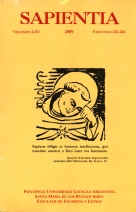Por favor, use este identificador para citar o enlazar este ítem:
https://repositorio.uca.edu.ar/handle/123456789/3594| Campo DC | Valor | Lengua/Idioma |
|---|---|---|
| dc.contributor.author | Livi, Antonio | es |
| dc.date.accessioned | 2019-06-01T17:55:51Z | - |
| dc.date.available | 2019-06-01T17:55:51Z | - |
| dc.date.issued | 2009 | - |
| dc.identifier.citation | Livi, A. Impossibilità di pensare Dio non esistente : il Proslogion di Anselmo d'Aosta come applicazione implicita dei moderni procedimenti di logica aletica [en línea]. Sapientia. 2009, 65 (225-226). Disponible en: https://repositorio.uca.edu.ar/handle/123456789/3594 | es |
| dc.identifier.issn | 0036-4703 | - |
| dc.identifier.uri | https://repositorio.uca.edu.ar/handle/123456789/3594 | - |
| dc.description.abstract | Resumen: La vera intenzione teologica di Anselmo d’Aosta nello scrivere il Proslogion e il vero significato del suo celebre unum argumentum vanno visti nella funzione che la ragione svolge necessariamente all’interno della vita di fede del cristiano. Anselmo, come Tommaso d’Aquino, non sostiene che l’esistenza di Dio sia un “articulus fidei” ma piuttosto uno dei “praeambula fidei”. La ragione naturale ha la certezza che Dio esiste, ancora prima della dimostrazione metafisica, e questo non fa che confermare l’assurdità di pensare che non esista il fondamento reale di tutte le cose esistenti. | es |
| dc.description.abstract | Abstract: The most famous Anselm of Canterbury’s work, the Proslogion, has been object of many different interpretations from the Middle Ages to our times. Almost all those interpretations deal with the sense and the goal of what Anselm called an «unum argumentum» for proving that God exists. Unfortunately, all major commentaries on Anselm’s argument ―especially those formulated by modern and contemporary philosophers― are founded on an interpretation of it as an «ontological argument». Now, this interpretation is quite wrong, since it implies the theory of «ideae innatae», a doctrine which is typical of Descartes but could not absolutely be attributed to Anselm. In this article a new interpretation is proposed. It is founded on the acknowledgement of the real intention that moved Anselm to write his work, whose former title was Fides quaerens intellectum, that is, Christian faith needs understanding. Anselm was concerned with the theological search of a deeper and more clear knowledge of what divine revelation says about God’s existence and God’s attributes, like potency, wisdom, mercy, and justice. Anselm realizes that divine truth is more and more comprehensible if the believer takes into account the very reasons of his believing and uses his reason for making his belief stronger. So, just in the first age of Scholasticism, using pure reason in the theological search is recognized as absolutely necessary for Christian faith. The teaching of Thomas Aquinas in the thirteenth century will be only a development of Anselm’s genial intuition. | es |
| dc.format | application/pdf | es |
| dc.language.iso | ita | es |
| dc.publisher | Pontificia Universidad Católica Argentina. Facultad de Filosofía y Letras | es |
| dc.rights | Acceso Abierto | es |
| dc.rights.uri | https://creativecommons.org/licenses/by-nc-sa/4.0/ | es |
| dc.source | Versión original impresa en Sistema de Bibliotecas UCA: Sapientia Vol. LXV, Nº 225-226, 2009 | es |
| dc.subject | RAZON Y FE | es |
| dc.subject | DIOS | es |
| dc.subject | ARGUMENTACION ONTOLOGICA | es |
| dc.subject | FILOSOFIA TEOLOGICA | es |
| dc.subject | Anselmo, Santo, ob. de Canterbury, 1033-1109 | es |
| dc.title | Impossibilità di pensare Dio non esistente : il Proslogion di Anselmo d'Aosta come applicazione implicita dei moderni procedimenti di logica aletica | es |
| dc.type | Artículo | es |
| uca.path | Sapientia|2009 Vol LXV nº 225-226 | es |
| uca.disciplina | FILOSOFIA | es |
| uca.filename | /home/data-uca-generic/folder_generic/impossibilita-pensare-dio-non-esistente/metadata.xml | es |
| uca.issnrd | 1 | es |
| uca.affiliation | Fil: Livi, Antonio. Pontificia Università Lateranense; Roma | es |
| uca.orden | 01 | es |
| uca.version | publishedVersion | es |
| item.languageiso639-1 | it | - |
| item.grantfulltext | open | - |
| item.fulltext | With Fulltext | - |
| Aparece en las colecciones: | SAP - 2009 Vol LXV nro. 225-226 | |
Ficheros en este ítem:
| Fichero | Descripción | Tamaño | Formato | |
|---|---|---|---|---|
| impossibilita-pensare-dio-non-esistente.pdf | 234,04 kB | Adobe PDF |  Visualizar/Abrir |
Visualizaciones de página(s)
170
comprobado en 30-abr-2024
Descarga(s)
1.144
comprobado en 30-abr-2024
Google ScholarTM
Ver en Google Scholar
Este ítem está sujeto a una Licencia Creative Commons

